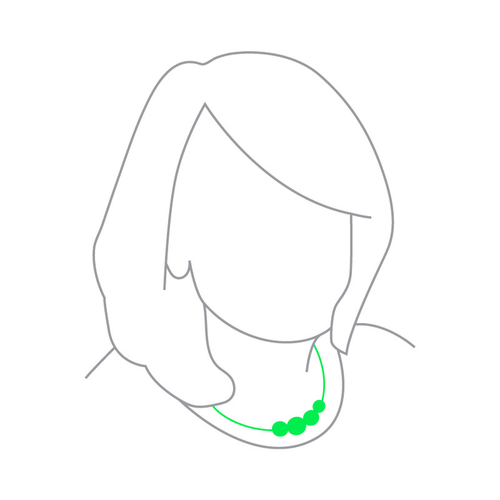Experienced options traders understand how ownership single-leg options and vertical spreads can assistance yous take advantage of directional moves, but with defined take chances. And because unmarried-leg options and vertical spreads have a vega component, they can be useful if you have a view on implied volatility.
So let'due south say you have a positive directional view on a stock, and you're considering buying a vertical phone call spread. Does it affair which strikes y'all cull? Yep, it tin. In a large manner. In fact, in some vertical spreads, the curt leg is then far out-of-the-coin (OTM), you might exist better off simply buying the single-leg choice. For more on deciding between vertical spreads and single-leg options, refer to this contempo article.
The Setup
Allow'due south look at some telephone call spreads on a stock that'south trading for $150. We'll compare a few spreads of varying widths using four strikes, from the at-the-money (ATM) 150-strike call to the far OTM 165-strike phone call. The strike price of each phone call, its theoretical value (TV), and its delta are shown in Tabular array ane below. We'll look at an ATM 5-point and 10-point spread, and an OTM v-point and 10-point spread. How are they different?
Note: When quoting these call spreads, the first strike quoted is the buy side; the second is the sell side. For example, "buying the 150–155 call spread" means y'all're buying the 150 strike and selling the 155 strike.
Strike Price
| Theoretical Value
| Delta
|
150
| 7.ten
| 0.52
|
| 155 | iii.fourscore
| 0.30
|
| 160 | i.70
| 0.fourteen
|
| 165 | 0.75
| 0.06
|
Table ane: CALL STRIKES. These call strikes are used in our examples to create the spreads for comparison. Prices and deltas included. For illustrative purposes only. By performance does non guarantee hereafter results.
Tabular array 2 gives a breakdown of each spread, its price, the Television receiver of the spread (taken every bit the difference betwixt the TVs of the strikes), and each spread's delta (the divergence between the individual strikes' deltas). Table 2 also shows:
- The breakeven point—the low strike plus the premium paid
- The maximum dollar return—the width of the strikes minus premium paid
- Stock prices (at selection expiration)—where the maximum gain and maximum loss are hit
The gains and losses in this example do not include transaction costs. Spreads and other multiple-leg option strategies tin entail substantial transaction costs, including multiple commissions, which may impact whatever potential return. These are avant-garde option strategies and often involve greater risk, and more circuitous risk, than bones options trades.
Width
| $5
| $10
| $5
| $x
|
Spread
| 150–155
| 150–160
| 155–160
| 155–165
|
Toll
| $three.30
| $5.forty
| $2.10
| $0.95
|
Delta
| 0.22
| 0.38
| 0.sixteen
| 0.08
|
Breakeven indicate*
| $153.30
| $155.twoscore
| $157.10
| $155.95
|
Max loss stock price*
| <$150
| <$150
| <$155
| <$155
|
Max gain stock toll*
| $155
| $160
| $160
| $165
|
Max $ return*
| $ane.70
| $4.lx
| $2.xc
| $9.05 |
* at expiration
Table 2: COMPARISON OF Different Phone call VERTICAL SPREADS. A comparison of four different phone call spreads, with varying strike widths and distance from the money. For illustrative purposes only. Past performance does not guarantee future results.
The Breakdown
Buying the 150–155 spread would give yous the lowest breakeven signal in the stock. This spread as well has the lowest price the stock has to reach ($155) in social club to hit its maximum gain if the trade is held until expiration.
Simply having the lowest breakeven indicate comes at a cost, which is that the 150–155 call spread offers the lowest maximum dollar return, $1.seventy (which is $170, since the options multiplier is 100). Fifty-fifty if yous consider that a good return on your premium invested, information technology pales in comparison to the $9.05 ($905 per spread) potential of the 155–165 call spread. But to get there, the stock has to rally an additional $ten past expiration.
And let's not forget: if the stock goes downwardly between now and expiration, no affair which spread you buy, you'll lose the unabridged premium, plus transaction costs.
Let's throw in some Goldilocks wisdom and wait at the 'tweeners. Both the 150–160 and the 155–160 have higher potential returns than the 150–155, with lower max price points for the stock than what the 155–165 requires. The indicate is, choosing your strike prices comes down to what you expect the stock to do, and when.
A Few General Guidelines
- Breakeven and maximum profit prices matter most if you lot're going to hold the trade until expiration.
- Narrower, closer-to-the-money call vertical spreads might be appropriate if you expect the stock to motility up slowly.
- Wider vertical spreads by and large take larger greeks—delta, gamma, theta, and vega—and thus have greater exposure to motility in the underlying, changes in implied volatility, and the passage of time compared to narrower spreads.
And one last note on strike selection—be practical. For example, if the curt strike of your vertical spread has very piddling premium in information technology, it might be more appropriate to just purchase the long strike as a unmarried leg and skip the vertical. Information technology's all nearly the adventure versus the potential advantage.

